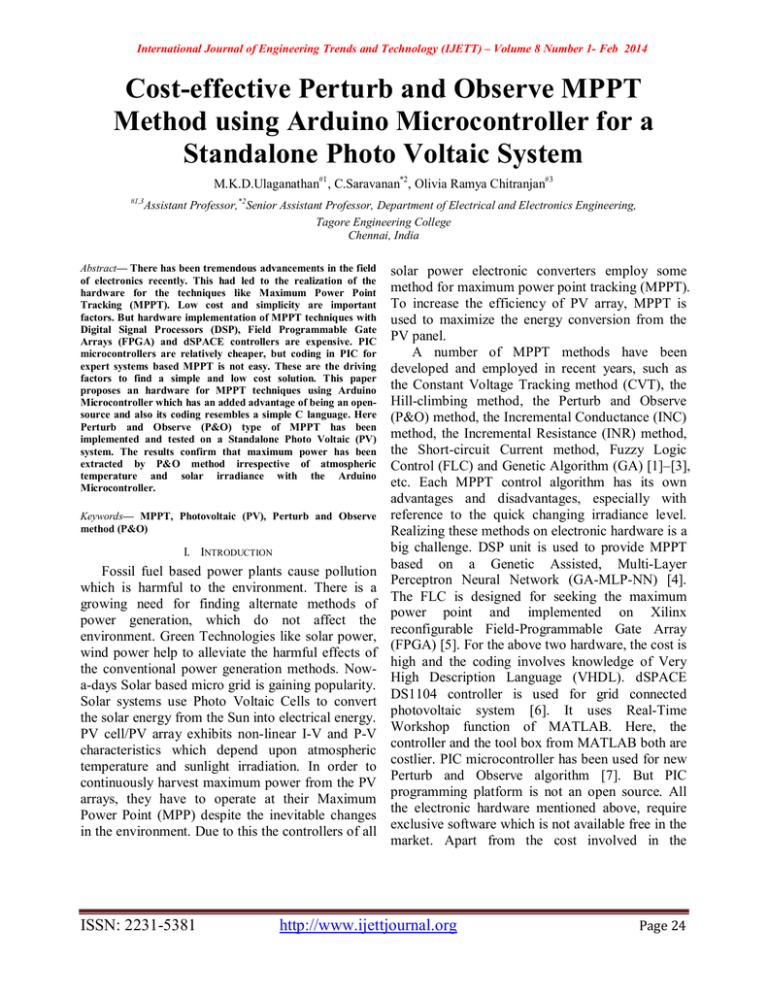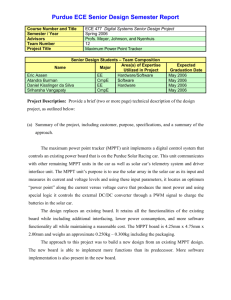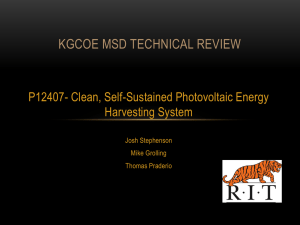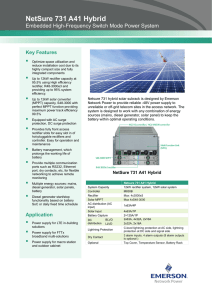Cost-effective Perturb and Observe MPPT Method using Arduino Microcontroller for a
advertisement

International Journal of Engineering Trends and Technology (IJETT) – Volume 8 Number 1- Feb 2014 Cost-effective Perturb and Observe MPPT Method using Arduino Microcontroller for a Standalone Photo Voltaic System M.K.D.Ulaganathan#1 , C.Saravanan*2, Olivia Ramya Chitranjan#3 #1,3 Assistant Professor,*2Senior Assistant Professor, Department of Electrical and Electronics Engineering, Tagore Engineering College Chennai, India Abstract— There has been tremendous advancements in the field of electronics recently. This had led to the realization of the hardware for the techniques like Maximum Power Point Tracking (MPPT). Low cost and simplicity are important factors. But hardware implementation of MPPT techniques with Digital Signal Processors (DSP), Field Programmable Gate Arrays (FPGA) and dSPACE controllers are expensive. PIC microcontrollers are relatively cheaper, but coding in PIC for expert systems based MPPT is not easy. These are the driving factors to find a simple and low cost solution. This paper proposes an hardware for MPPT techniques using Arduino Microcontroller which has an added advantage of being an opensource and also its coding resembles a simple C language. Here Perturb and Observe (P&O) type of MPPT has been implemented and tested on a Standalone Photo Voltaic (PV) system. The results confirm that maximum power has been extracted by P&O method irrespective of atmospheric temperature and solar irradiance with the Arduino Microcontroller. Keywords— MPPT, Photovoltaic (PV), Perturb and Observe method (P&O) I. INTRODUCTION Fossil fuel based power plants cause pollution which is harmful to the environment. There is a growing need for finding alternate methods of power generation, which do not affect the environment. Green Technologies like solar power, wind power help to alleviate the harmful effects of the conventional power generation methods. Nowa-days Solar based micro grid is gaining popularity. Solar systems use Photo Voltaic Cells to convert the solar energy from the Sun into electrical energy. PV cell/PV array exhibits non-linear I-V and P-V characteristics which depend upon atmospheric temperature and sunlight irradiation. In order to continuously harvest maximum power from the PV arrays, they have to operate at their Maximum Power Point (MPP) despite the inevitable changes in the environment. Due to this the controllers of all ISSN: 2231-5381 solar power electronic converters employ some method for maximum power point tracking (MPPT). To increase the efficiency of PV array, MPPT is used to maximize the energy conversion from the PV panel. A number of MPPT methods have been developed and employed in recent years, such as the Constant Voltage Tracking method (CVT), the Hill-climbing method, the Perturb and Observe (P&O) method, the Incremental Conductance (INC) method, the Incremental Resistance (INR) method, the Short-circuit Current method, Fuzzy Logic Control (FLC) and Genetic Algorithm (GA) [1]–[3], etc. Each MPPT control algorithm has its own advantages and disadvantages, especially with reference to the quick changing irradiance level. Realizing these methods on electronic hardware is a big challenge. DSP unit is used to provide MPPT based on a Genetic Assisted, Multi-Layer Perceptron Neural Network (GA-MLP-NN) [4]. The FLC is designed for seeking the maximum power point and implemented on Xilinx reconfigurable Field-Programmable Gate Array (FPGA) [5]. For the above two hardware, the cost is high and the coding involves knowledge of Very High Description Language (VHDL). dSPACE DS1104 controller is used for grid connected photovoltaic system [6]. It uses Real-Time Workshop function of MATLAB. Here, the controller and the tool box from MATLAB both are costlier. PIC microcontroller has been used for new Perturb and Observe algorithm [7]. But PIC programming platform is not an open source. All the electronic hardware mentioned above, require exclusive software which is not available free in the market. Apart from the cost involved in the http://www.ijettjournal.org Page 24 International Journal of Engineering Trends and Technology (IJETT) – Volume 8 Number 1- Feb 2014 hardware/software, specialized coding skills are required. These factors have contributed the need to find an alternate solution. This paper presents an MPPT controller realized on a low cost Arduino microcontroller. P&O MPPT method is adopted on an Arduino Uno board. Experimental verification is done by implementing this controller to a PV stand alone system. II. PV MODEL The use of photovoltaic model in the simulation software is important for the study of a PV system. The power that can be obtained from a PV module is affected by the environmental conditions such as the change of irradiation level and operating temperature. Therefore, it is important to have accurate PV model that can be used for simulation. In recent years, several circuit orientated PV models have been proposed. Among them, the most commonly used model is the single diode PV model that consists of a single diode, a parallel and a series resistor. Fig. 1 shows the single diode PV model. I pv I SC K i T Tn H (2) where, ISC is the PV cell’s short-circuit current at a 25°C and 1kW/m2, Ki is the cell’s short-circuit current temperature coefficient, Tn is the cell’s reference temperature, and H is the solar irradiation in kW/m2. I SC K i T Tn Io expVOC KV T Tn / aN SVt 1 (3) where, VOC is the cell’s open circuit current at a 25°C and 1kW/m2, KV is the cell’s open circuit voltage temperature coefficient, NS is the number of cells connected in series per string, Vt is the thermal voltage given by, Vt = KT/q. The terminal equation of PV array for the current is given as, q V IRSM 1 I N p I pv N p I o exp N S KTa (4) where RSM N S RS / N p , Ns is number cells in series and Np is the number cells in parallel. Based on the above equations, PV array model is simulated in Matlab/Simulink environment. III. PV MPPT CONTROLLER This section describes the MPPT method and the microcontroller used for this paper. Fig. 1. PV cell equivalent circuit model A. MPPT Method The transcandal equation of a solar cell is given as, qV IRS V IRS I I pv I o exp 1 KTa RSh (1) where, Ipv is a light-generated current or photocurrent, Io is the cell saturation current at dark time, q (= 1.6 ×10 −19 C) is an electron charge, K (= 1.38 ×10 −23J/K) is a Boltzmann’s constant, ‘T’ is the cell’s working temperature, ‘a’ is an ideality factor, RSh is a shunt resistance, and RS is a series resistance of solar cell. ISSN: 2231-5381 There are a number of MPPT methods. Each one has got its own algorithm and therefore its own advantages/disadvantages. But the purpose of each one of these methods is to achieve maximum efficiency. They differ in terms of the required hardware, complexity, cost and so on. B. Perturb and Observe Method Perturb and Observe method is a one type of MPPT algorithm. This method utilizes the photovoltaic array voltage/current to compute the maximum power. This method provides MPP tracking even in changing atmospheric conditions with accuracy. Also, it is easy to implement. Since, it is very familiar to the Solar Power System http://www.ijettjournal.org Page 25 International Journal of Engineering Trends and Technology (IJETT) – Volume 8 Number 1- Feb 2014 applications, detailed discussion of this excluded in this paper. T ATmega328 5V 7-12V 6-20V 14 (6 PWM outputs) 6 40 mA 50 mA 32 KB (ATmega328) 2 KB (ATmega328) 1 KB (ATmega328) 16 MHz g + R S m G + v v 1 - Insol ati on [R] PV model [vbo] [i bo] I_Load [vbo] V_Load [i bo] I [ibo] D Scope Puls es Fig. 2. A standalone PV system with P&O MPPT To validate the performance of the P&O MPPT algorithm, a MATLAB SIMULINK model developed for a standalone PV module equipped with a DC-DC boost converter and a resistive load as shown in Fig. 2. The PV model has been developed at the standard conditions (1000W/m2, 25oC). The simulation has been carried out at an irradiation of 1000W/m2 and at a temperature of 30oC. The P&O MPPT is simulated in sub system block. The sampling time has been chosen to be 25 msec. The output power of 69W is obtained as shown in Fig. 3. Time(Sec) IV. SIMULATION RESULTS The important things to be considered for MPPT System design are the switch-mode topology and the control mechanism. In this paper boost converter topology is chosen that will maximize the efficiency of the PV array. DC/DC converter has the function of impedance conversion. PV array are connected with load by DC/DC converter. By adjusting the duty cycle of DC/DC converter, the PV array can always work at maximum power point. C2 Mosfet [vboost] Irradiance(W/m2) TABLE I SPECIFICATIONS OF ARDUINO B OARD D + i [R] 1000 [vbo] i - + C1 Power (W) The Arduino microcontroller is an easy to use yet powerful single board computer that has gained considerable traction in the hobby as well as professional market. With the use of Arduino boards, we can create interfaces circuit; write programs and control motors and lights very easy. The Arduino uses a simple programming language which is derived from C. This language has limited instructions sets and thus becomes more users friendly. Here, Arduino Uno board based on the ATmega328 is used for implementing P&O MPPT method. It has 14 digital input/output pins. Among all the output pins, 6 pins can be used as PWM outputs. And it has 6 analog inputs, a 16 MHz ceramic resonator, a Universal Serial Bus connection, a power jack, an ICSP header and a reset button. It consists of everything needed to support the microcontroller. Table I shows the specifications of Arduino Uno board. ISSN: 2231-5381 + + + 30+273.15 Temperature[K} C. Arduino microcontroller Specifications Microcontroller Operating Voltage Input Voltage Input Voltage (limits) Digital I/O Pins Analog Input Pins DC Current per I/O Pin DC Current for 3.3V Pin Flash Memory SRAM EEPROM Clock Speed [i bo] Di ode L Fig. 3. Simulation results of P&O MPPT at 1000W/m2, 300 C Further the simulation has also been carried out for change in irradiation levels viz., 1000, 800, 200, 1000, 900W/m2 at a constant temperature of 250C. The output power obtained is shown in Fig. 4. These results also confirm that P&O MPPT improves the dynamic performance and tracks the MPP accurately. http://www.ijettjournal.org Page 26 International Journal of Engineering Trends and Technology (IJETT) – Volume 8 Number 1- Feb 2014 Power (W) Irradiance(W/m 2) 5). The Fig. 6 below shows the snapshot of the GUI of Arduino software. Time (Sec) Fig. 4. Simulation results of P&O MPPT at [1000,800,200,1000,900]W/m2, 250 C V. HARDWARE DETAILS Hardware Setup- The hardware setup of PV standalone system with WS 75W PV module is shown in Fig. 5. The DC-DC boost converter, Arduino Uno board, MOSFET driver circuit and power supply unit are integrated on a wooden plot form. Voltage and current sensors are realized on a printed circuit board. An 18 ohm resistor is used as a load. Fig. 6. GUI of Arduino software with P&O MPPT coding. This whole hardware setup is tested at open space and the result obtained is shown in Fig. 7. The output voltage is shown for 34.80C temperature and 721 W/m2 irradiation condition. With 36.2V across load and 1.2A current delivered to the load resistor, P&O MPPT extracts 43.4W from the PV module. This is obviously nearby value of maximum power (45W) to the corresponding test condition. The simulation result for this condition is also shown in Fig. 8. 36.2 V across load Pulses at PWM pin 5 Fig. 7. The output voltage across load and PWM output from microcontroller. Fig. 5. Hardware setup of 75W PV standalone system Coding- The coding is carried out on Arduino software version 1.0.1. The instruction set has been prepared from the P&O method flow chart. The program is designed to use hardware timer2 to generate a fast PWM on OC2B (Arduino digital pin ISSN: 2231-5381 http://www.ijettjournal.org Page 27 Power (W) International Journal of Engineering Trends and Technology (IJETT) – Volume 8 Number 1- Feb 2014 Time (Sec) Fig. 8. The simulation result for 34.80C temperature and 721 W/m2 irradiation condition. VI. CONCLUSION A simple hardware model of P&O method using Arduino microcontroller is presented. Simulation results confirm that this method can track the maximum power point quickly without oscillation. Hardware realization of MPPT controller by Arduino microcontroller is achieved and the performance evaluation holds good. It is envisaged that the work can be very useful to realize a simple and low cost MPPT controller for all renewable sources. REFERENCES [1] [2] [3] [4] [5] [6] [7] Trishan Esram, and Patrick L. Chapman, “Comparison of Photovoltaic Array Maximum Power Point Tracking Techniques”, IEEE Trans. On Energy Conversion, vol. 22, pp. 439–449, June 2007. M. Qiang , S. Mingwei, L.Liu, and M.G.Josep, “A novel improved variable step-size incremental-resistance MPPT method for PV systems”, IEEE Trans. Indus. Electron, vol. 58, no. 6, pp. 2427–2434, Jun. 2011. D. P. Hohm and M. E. Ropp, “Comparative Study of Maximum Power Point Tracking Algorithms”, Progress in Photovoltaics: Research and Applications, vol. 11, pp. 47–62, 2003. R. Akkaya, A.A. Kulaksız, O¨ . Aydog˘du, “DSP implementation of a PV system with GA-MLP-NN based MPPT controller supplying BLDC motor drive”, Energy Conversion and Management 48 (2007) 210–218. A. Messai, A. Mellit, A. Massi Pavan, A. Guessoum , H. Mekki, “FPGA- based implementation of a fuzzy controller (MPPT) for photovoltaic module”, Energy Conversion and Management 52 (2011) 2695–2704. Z.A. Ghani, M.A. Hannan, A. Mohamed, “Simulation model linked PV inverter implementation utilizing dSPACE DS1104 controller”, Energy and Buildings 57 (2013) 65–73. Lotfi Khemissi, Brahim Khiari, Ridha Andoulsi, Adnane Cherif, “Low cost and high efficiency of single phase photovoltaic system based on microcontroller”, Solar Energy 86 (2012) 1129–1141. ISSN: 2231-5381 http://www.ijettjournal.org Page 28



